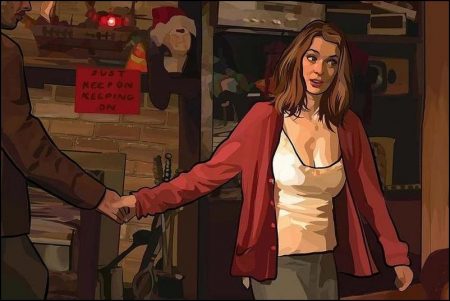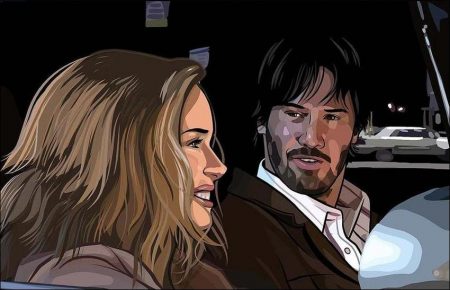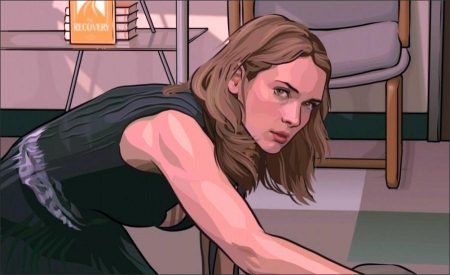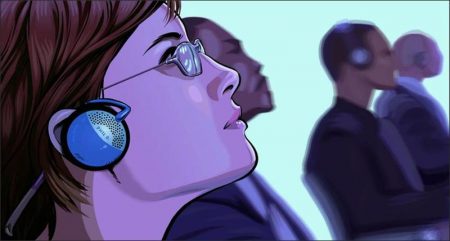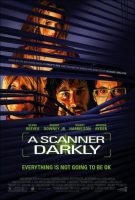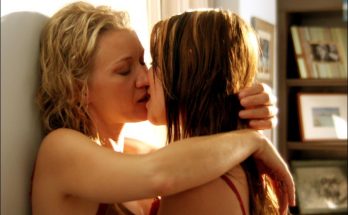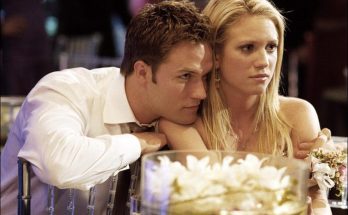A Scanner Darkly is one of our father’s most personal stories because much of it is based on his own experiences,” add Leslie and Hackett. “For this reason, it was especially important to us that it be done with all of the right intentions. His struggle with drug abuse is well documented, and he (and we) have witnessed many casualties along the way. The novel is filled with his humor and his own tragedies, and Richard’s screenplay managed to capture these key elements.”
Linklater’s script also grabbed the attention of the acting community. “Richard wrote a really great adaptation and representation of the book,” comments Reeves, who is no stranger to science fiction with turns in the “Matrix” trilogy. It was Reeves who would tackle the complicated role of Bob Arctor.
“There is a clear line in the beginning when there’s Arctor inside of Fred. Then they start to come together and mesh, and there’s a point where they are all destroyed, or brought to neutral,” explains Reeves of his complex role.
These split personalities made for an interesting few weeks. “While I was playing Arctor I learned about Fred, and when I was playing Fred I learned a bit about Arctor,” says Reeves. “They both definitely feel differently about themselves internally. There were days where it was confusing, but I got a lot of enjoyment out of the experience of playing those scenes and figuring it out.” “The success of this movie depends on how much you care about Bob Arctor and his situation,” says Linklater. “Keanu brings out that kind of empathy. You feel something for him in his situation. You care about him and what he’s going through.”
Robert Downey Jr., who signed on to play Jim Barris, responded to the script as well. “I thought it was probably the strangest script I’ve ever read,” he admits. “But I knew Keanu was doing it and Richard was directing it, and I thought, ‘these guys are pretty smart and know a good role. I wonder how this will turn out.’” Downey Jr. describes the flamboyant Barris this way: “This guy’s off the hook. He reminds me of those propeller-head guys that you knew in high school who knew how to take apart a bike and put it back together and other freaky stuff. I thought it would be really fun to play him.”
“Rick called me up and said, ‘I wrote this part for you,’” says Rory Cochrane, “I actually was concerned because I didn’t want to repeat the performance I did in ‘Dazed and Confused.’ So I thought it would be challenging to try to do something different. Freck’s probably the most tweaked out. The guy’s lost it,” says Cochrane of his offbeat character. “Most of the characters don’t have a real sense of reality anymore, but he’s probably the farthest out there. I don’t think Freck relates to anybody. He probably has the intention of relating to people, but he just can’t.”
Woody Harrelson, who came on board to play the role of Ernie Luckman, admits he was somewhat puzzled by the script at first. “It’s a bizarre kind of story; it’s stories within stories, strange realities within strange realities,” he explains. “You don’t know what’s real and what’s illusion.” Harrelson had no problem grasping the essence of his character, however. “Luckman has an innocence about him, even though he’s kind of crazy and messed-up in so many ways. There’s a lot of duplicity with all of these characters, except for, oddly enough, Luckman, which really suited me. It’s interesting that he’s the only one who’s not pretending—at least that’s the way I believed it.”
“There are no ‘weekend warriors’ on the D. You’re either on it, or you haven’t tried it.”
Arctor, Barris, Luckman, and Freck create a “kind of surrogate degenerate family,” in the words of Downey Jr. “It’s the general dysfunction that happens in a house where you have three guys sharing a sink. What binds them together is this agreement to be insane and cosign each other’s demise.”
The dynamic of the foursome reminded Linklater of his own experiences from years ago where friends would end up moving in with friends. In the movie, these guys somehow ended up as roommates in Bob Arctor’s house. Now it’s this house for ne’er-do-wells who are living totally outside the mainstream.”
The environment can bring out the worst in the foursome, but the more disturbing catalyst for their behavior is Substance D; a powerful drug with the ability to produce a pervasive paranoia in its users— a paranoia about their own substance use, about the government, about other people.
“These people are wrestling with their demons. The drugs push them to this level of fear. Then they feel sublime and happy… then fear again,” says Harrelson. “The characters ricochet back and forth between all these emotions.” Under the influence of Substance D, paranoia is the elevated emotion.
By extension, surveillance becomes the only perceived way to survive. No one and nothing is as it seems – a central theme in the movie. Dick has been described as “the master of the psychological pratfall, the metaphysical freefall, the political conspiracy within a conspiracy within a conspiracy. He is an astute guide to the shifting realities of the twenty-first century.
“Five years ago, Philip K. Dick’s vision of the future seemed at the very least a bit fanciful or paranoid, but now it seems like a highly plausible possibility,” says Mark Gill, president of Warner Independent Pictures, of the story. “There’s so much surveillance and counter surveillance and people ratting each other out and paranoia about whether or not you can trust the guy that you’ve been hanging out in the living room with for two years,” says Downey Jr. “It’s your general garden variety mistrust.” “You don’t really know what anybody means. Or who you can trust,” adds Linklater. “In this kind of paranoid world that they create for themselves, suddenly everyone’s suspect.”
Echoes Ryder of the double-crossing relationship between Donna, Arctor, Barris, Luckman and Freck: “You don’t know who is telling the truth, who’s working for who, who’s screwing who over. You never get all the answers. It’s like rats in a cage—the government makes people turn against each other by giving them false information, making them confused while getting them hooked on drugs to be undercover.”
“It does make you wonder—something like 70% of your life you’re either on camera or being documented in terms of your transactions,” says Reeves. “What does that do? What do you become? Who’s wielding the camera? What are they doing with the information?”
Linklater agrees that the story resonates loudly in light of today’s political and social climate. “The paranoia that these guys feel is similar to our own paranoia in the world, with the all-encompassing war on terrorism. It kind of puts a cloud over all of us as a culture. It’s like the new McCarthyism, the new witch hunt. In the film, we’re able to present this environment but with an often humorous perspective as laid out by Dick in his novel.”
Austin City Limits
Linklater fine tuned the script during two weeks of rehearsals with the cast in Austin, Texas before principal photography began. “Richard really informed the final script with what we did during rehearsals,” says Reeves. “The characters were allowed to develop, and eventually became a fusion of the character in the novel, Richard’s adaptation, and what we as actors brought to it. It was great to work like that because you’re participating in it.”
The Austin location—Linklater’s hometown—seemed to put everyone in a relaxed and creative mood. “It wasn’t like a normal set,” says Ryder. “Everyone was so mellow and yet they worked really hard. They have a different approach—more loose and free, with a real flow to the way everybody worked together.”
Production began on the warm, sunny morning of May 17, 2004. Temperatures would hover around 90 degrees for the majority of the day and the production. Each actor prepared—or didn’t prepare—for the unique project in his own special way. Says Cochrane: “I came up with my character, like, five minutes before I got on the elevator to go to work. I don’t know how you prepare for something like this.”
Downey Jr’s preparation was more intense. “The last three or four films I’ve done combined didn’t have as much dialogue as I had in the first three days on this movie,” he reports. He devised a mindboggling memorization method that consisted of writing out his copious dialogue in run-on sentences, studying them, then converting the sentences into more easily retained acronyms to get through the dense material. “If I don’t have a process, I have no way of knowing anything,” he says.
Reeves relied heavily on the original Philip K. Dick book during preparation and filming. “I took the book along with me. I would mark down each scene to the corresponding page in the book, then I would write down certain comments that Philip K. Dick had written about the character or what the character was saying or how he felt. I would read it and feel it and try to match it until I felt like the character was in the right place. I really followed the book.”
All of the actors were comfortable in the capable hands of their director. “Rick’s a good guy. He lets you be creative and offer ideas,” says Cochrane. “He knows exactly what he wants, but he gets a bunch of good people around him, so it’s a collaboration.” “Richard wants you to figure it out for yourself,” echoes Ryder. “He lets you explore another direction instead of telling you what the interpretation of the scene is, and I appreciated that. You feel so much more a part of it when a person is making you participate in it and forcing you to search out what you feel is the truth.”
“Richard is fearless,” Ryder continues. “And he’s one of the finest directors I’ve ever worked with.” The first location for the unit was Arctor’s house, which came in the form of a three-bedroom, twobath single family home on Eric Circle in southeast Austin. The tenants vacated a month before production began, leaving the house in a shambles. Production designer Bruce Curtis actually had to make improvements to get the home to look like Arctor’s shabby digs.
“Finding Arctor’s house was the biggest challenge. We needed something that looked like Anaheim, but Richard wanted a space where the action could be filmed from one end of the house to the other,” says location manager Peter Atherton. “When we found this house, we knew it was perfect.”
The filmmakers scouted Anaheim exteriors to get the architectural style down before searching nearly 60 Austin houses to find the perfect home for Arctor. Anaheim was created in postproduction: “We shot a lot of exteriors in Anaheim, and then composited them into the footage we shot in Austin,” says Linklater.
Even though it’s technically a home of the future, the style of Arctor’s house is surprisingly retro. This is in keeping with Linklater’s philosophy about the production design, which would later be reflected in the animation—to avoid the kind of clichéd portrayal of the future that many sci-fi movies fall prey to. “While it may be considered science fiction, it didn’t feel that way to me,” says Linklater. “It felt very contemporary and real-world, and though in the future, the world has changed a little bit, you’re still going to live your life.
“That always bugged me about movies set even a little into the future. They tend to change people’s behavior. Things get serious! You see these antiseptic worlds, where people are robotic or something. And I wonder, ‘When did people lose their sense of humor? The worse things get the more outrageous people become, but they still find humor and irony in life.’”
Another major location was the Braker Center office park in northwest Austin, owned by General Electric. Braker stood in for several locations, including Freck’s apartment, the New Path reception area, hallway and cafeteria, and the phone scanning room. Other Austin locations included the Mi Tienda market, Arkie’s Grill, Culvers Grill, and a private apartment at 1st and Ephart. The cornfield scenes were shot on a farm in the town of Elgin, about 25 miles outside of Austin. The farm, which grows cotton and corn, belongs to fourth generation Texans who originally came from Sweden, were flooded out of Galveston, and finally moved to Elgin.
Philip K. Dick’s daughters, Laura and Isa, visited the set during filming and had a chance to speak with the actors about some of the more personal aspects of the story. “Without exception, every person we spoke to—actors, producers, and crew—was entirely gracious and enthusiastic about the work of Philip K. Dick. They welcomed our input, and made us feel a part of this project,” says Hackett.
Since the film would be animated on top of the live action, makeup and lighting were less of a concern, as were equipment like booms or mics sneaking into a scene. They could be “animated out” later. “Anything solid they can fix,” says director of photography Shane Kelly. “It was a new area for me to deal with. I learned what the animators can fix and what they can’t fix, what I can get away with and what I can’t.”
Some of Kelly’s duties were unique to the animated project. “I tried to get a good image for the animators to work with. I worked off the monitor a lot, because something that stands out on an eight inch monitor to me will stand out down the line,” he explains. “I definitely shot and composed with the animators in mind. I also gave them a color palette to use, because they sample the colors from the live action.”
The animators visited the set on occasion to see what they would be working with. “I talked to them several times, and once in a while the compositor showed up on set to say, ‘I really need this and I really need that,’” says Kelly.
Though Kelly opted for a general lighting scheme to give Linklater and the actors the freedom to move around within the set and change blocking if needed, his composition and lighting became a little more graphic, “almost as though I was working in black and white,” he says.
Did the actors make adjustments to their performances knowing the film would be animated? It depends on whom you ask. “I tried to do more weird facial gestures,” says Cochrane. “I took some liberties that I normally wouldn’t. I was a little more off the wall.”
Harrelson agrees. “I probably went a little more over the top than I would normally because I knew it was going to be animated,” he says. “It just seemed to give me license to get a little more nutty, and I’m sure Robert felt likewise.”
“I didn’t think of it as being animated,” says Ryder. “I thought that we were just filming a movie. I couldn’t think about that. I was just doing my same job.” Reeves was most aware of the production being animated while performing in the scramble suit. He says, “I didn’t have my face to convey information, so I might make a move a little bigger. I think some of the other actors would occasionally be more animated. But for me, I only did it mostly in the scramble suit.”
A Graphic Novel Come to Life: The Animation Process
“A Scanner Darkly” was shot, locked and edited, just like a normal live-action film. After transferring to the animators via Quicktime, “We bring it into the world of animation,” says Tommy Pallotta, “and make the same movie twice.” The ‘second movie,’ which gives the hard reality of the first a trippy, pop art twist, was created by a 15-month long computer animation process designed to paint reality, not mimic it. The “painterly” process of interpolated- rotoscoping allows animators to paint over live action DV footage in ways similar to putting brush strokes on paper or canvas. The process frees animators from having to hand-draw each line in every frame. Instead, the computer connects fluid lines and brush strokes across a wide range of frames to create lifelike human movement.
The process used in “A Scanner Darkly” is a further evolved version than the one used in “Waking Life.” There are several creative differences between the films as well. Say’s Linklater, “On ‘Waking Life,’ one scene could be wildly different than the one that followed. But on this film, we were always thinking in terms of a graphic novel that would have a similar design throughout, having a consistent look was one of our overriding ideas from the start.” Says Pallotta, “We worked more with illustrators as opposed to painters, comic artists, sculptors—people who didn’t have any sort of animation background. We wanted this film to have a singular visual style.”
The animation team looked at one piece of video at a time. The software enables animators to create everything from flat looks to watercolors. The drawing is done directly on computer; animators can go back and forth one frame at a time. Instead of simply saving an image, the computer recalls every brushstroke of the animator. The outline drawn is then filled with color—a “frozen layer” can also be created in the background that doesn’t move. The layers can be separated and edited as needed. Animators can even preview a scene with audio to check their progress. To create continuity in the color, the software enables the animators to “pick up” the color of an object in live action and recreate it on computer.
Despite the shortcuts that technology affords, the animation is still a painstaking process. It took up to 500 hours to make one minute of “A Scanner Darkly” with 30 people working full time on the project every day. The animators also had to research their characters and their actors.
“The animation team became familiar with the personalities they were working with,” says Downey Jr. “It enhanced things so much.”
The process ultimately offers Linklater the opportunity to let his imagination run wild. “I don’t feel there are any limitations to what we can do in post-production,” he says. “That’s what’s fun about this. We’ve created another world.”
No one is more excited to see the finished product than the actors themselves. “As time went on I really felt like it was going to be something special and I felt privileged to be a part of it,” says Harrelson. This feeling was shared by the daughters of Philip K. Dick. “This amazing group of filmmakers—true Philip K. Dick fans—and the Philip K. Dick Trust came together to get this project made. It meant so much to us.”
Linklater says it was imperative to portray “A Scanner Darkly” honestly because “I felt like I had Philip K. Dick, his family, and millions of fans who feel a special relationship not only to him, but to this particular work, out there. I felt like I had a weight on me. It’s a little daunting, but I also felt like I was up for that challenge. I’m happy, because I don’t think they will be disappointed at the end of the day.”
And how does Linklater explain the movie to non-Philip K. Dick fans, those unschooled in the author’s mind-altering, groundbreaking brand of science fiction? “That’s my favorite—when people ask me about it,” says Linklater. “I say, ‘it’s kind of like a nightmare that sneaks up on you—funny, funny, funny, and then darker than you could imagine. It’s like so much in life.’”
A Scanner Darkly (2006)
Directed by: Richard Linklater
Starring: Keanu Reeves, Winona Ryder, Robert Downey Jr., Woody Harrelson, Rory Cochran, Natasha Janina Valdez, Angela Rawna, Eliza Stevens, Sarah Menchaca, Chamblee Ferguson
Screenplay by: Richard Linklater
Production Design by: Bruce Curtis
Cinematography by: Shane F. Kelly
Film Editing by: Sandra Adair
Costume Design by: Kari Perkins
Set Decoration by: Joaquin A. Morin
Music by: Graham Reynolds
MPAA Rating: R for drug and sexual content, language, a violent image.
Distributed by: Warner Independent
Release Date: July 7, 2006
Views: 1138
